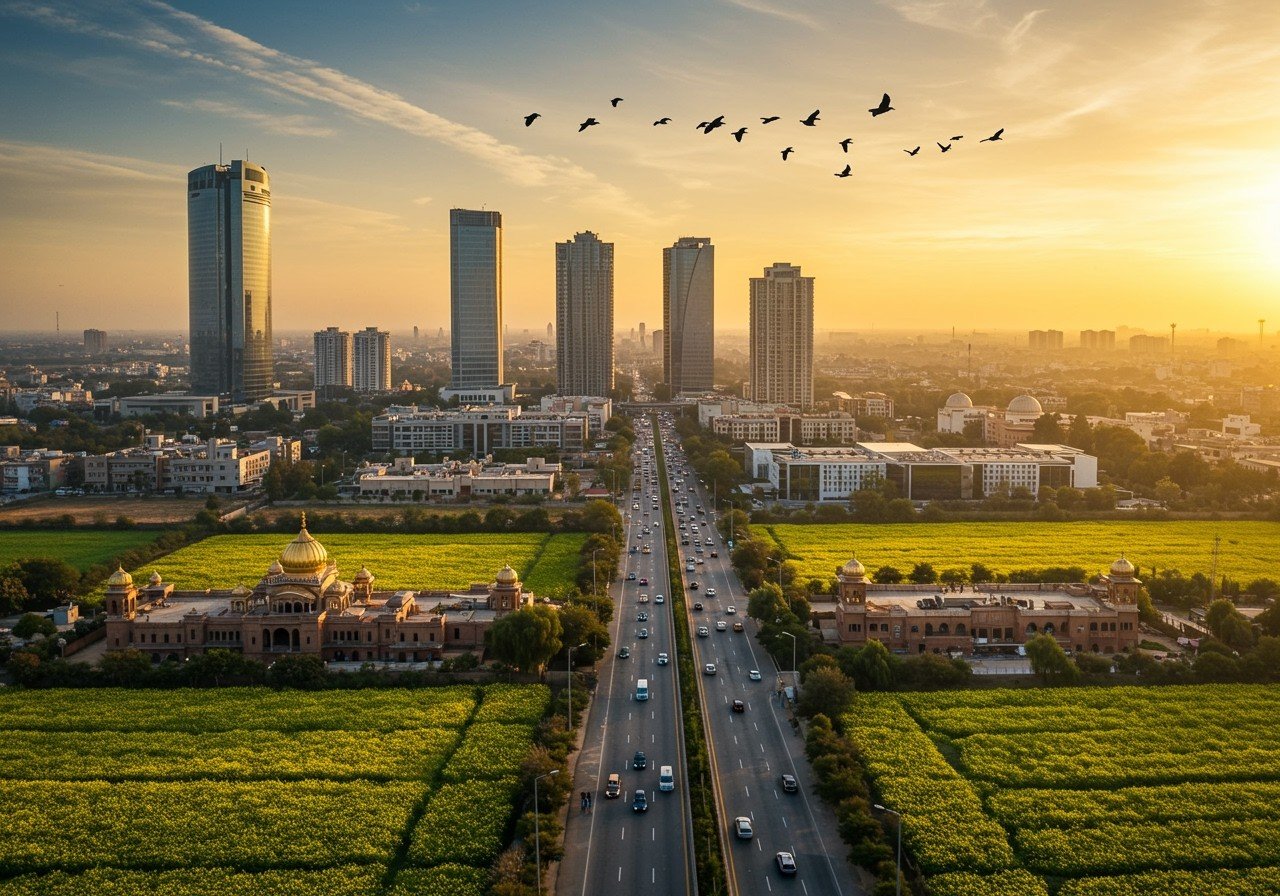
Punjab, renowned for its agricultural heritage, is experiencing a significant urban transformation. Cities like Chandigarh, Ludhiana, and Amritsar are at the forefront of this evolution, showcasing remarkable growth and development. This blog delves into the changing urban landscape of Punjab, exploring the infrastructure advancements, economic activities, cultural shifts, and future prospects shaping these urban centers.
Chandigarh: A Model of Urban Development
Chandigarh, a meticulously planned city designed by Le Corbusier, stands as a testament to modern urban planning. Its unique layout and efficient infrastructure are key features contributing to its success. Here’s a closer look:
- Architectural Marvels: Chandigarh boasts iconic structures like the Capitol Complex and the Open Hand Monument, showcasing its distinctive architectural style and attracting visitors from around the globe. These landmarks contribute significantly to the city’s cultural identity and tourism appeal.
- Green Spaces: Sukhna Lake and the Rock Garden offer serene escapes within the city, promoting a healthy and sustainable urban lifestyle. These green lungs are essential for maintaining ecological balance and enhancing the quality of life for residents.
- Administrative Hub: Serving as the capital of both Punjab and Haryana, Chandigarh plays a crucial administrative role, attracting government institutions, businesses, and professionals, further fueling its economic growth.
Chandigarh’s economy has diversified beyond traditional sectors, with significant growth in IT and service industries. This growth has created numerous job opportunities and attracted investments. The city’s vibrant cultural scene, encompassing museums, theaters, and festivals, celebrates Punjabi heritage while embracing modern influences. Future development plans focus on smart city initiatives to enhance connectivity, safety, and sustainability.
Ludhiana: The Industrial Powerhouse
Ludhiana has earned its reputation as an industrial powerhouse, particularly in textiles, manufacturing, and bicycle production. This industrial growth has been a major driver of the city’s urban development:
- Residential Expansion: Ludhiana’s growing population has led to a surge in demand for residential and commercial spaces, resulting in the development of new housing projects and business districts to accommodate this growth. The expansion also impacts peripheral areas, leading to integrated urban development.
- Infrastructure Developments: The city has witnessed significant improvements in its transportation networks, including road expansions and upgraded public transport systems. Healthcare facilities have also seen substantial advancements, catering to the needs of the growing urban population.
- Educational Institutions: Ludhiana is home to numerous educational institutions that nurture skilled professionals, contributing to the city’s workforce and driving its economic growth. These institutions play a vital role in equipping the population with the skills needed for the evolving job market.
Ludhiana’s cultural landscape is a blend of tradition and modernity, with bustling traditional markets coexisting alongside modern shopping malls. The city is actively addressing environmental challenges arising from industrialization through sustainable measures. Future prospects include smart city projects aimed at promoting sustainable urban development and enhancing the quality of life for its residents.
Amritsar: The Spiritual Heart
Amritsar, home to the Golden Temple, holds immense spiritual and historical significance. Its urban development is carefully planned to balance preserving its heritage with meeting the needs of a growing city:
- Infrastructure Improvements: Amritsar has seen substantial upgrades to its infrastructure, including improved roads, enhanced public transport systems, and expanded airport facilities to accommodate the increasing number of tourists and pilgrims. These improvements enhance accessibility and connectivity within the city and beyond.
- Hospitality Growth: The tourism sector in Amritsar is booming, driving the growth of the hospitality industry. New hotels, restaurants, and other tourism-related businesses are emerging to cater to the influx of visitors, boosting the local economy.
- Balancing Heritage: Amritsar is committed to preserving its rich historical and cultural heritage while accommodating modern development. This involves careful urban planning and conservation efforts to ensure that the city’s unique character is maintained amidst growth.
Advancements in education and healthcare are contributing to Amritsar’s overall development. The city’s vibrant cultural landscape, with its festivals, markets, and entertainment options, continues to thrive. Future plans focus on smart city initiatives and sustainable growth to ensure a harmonious blend of tradition and progress.
Economic Impacts of Urbanization
The ongoing urbanization in Punjab has brought about significant economic benefits:
- Attracting Investments: Improved infrastructure and a growing urban population have attracted investments across various sectors, fueling economic growth and creating new opportunities. The development of special economic zones and industrial parks further enhances the investment climate.
- Rise of Service Sectors: The service sector, including IT, healthcare, education, and tourism, has witnessed substantial growth, diversifying the state’s economy and providing employment opportunities for a skilled workforce. This shift towards a service-based economy is a key characteristic of urban development.
- Impact on Traditional Industries: While agriculture remains an important sector, urbanization has led to a shift towards more urban-centric economic activities. This necessitates adapting traditional industries to the changing economic landscape and exploring new avenues for growth.
Government policies, such as those implemented by the Punjab Urban Planning and Development Authority (PUDA), established in July 1995 under the Punjab Regional and Town Planning and Development Act, 1995, play a crucial role in supporting urban growth and development. PUDA focuses on planned urban development, including residential, commercial, and industrial spaces, using advanced technology and town planning norms. PUDA operates in various regions, including S.A.S. Nagar, Jalandhar, Bathinda, Patiala, and Amritsar, among others. It also engages in capacity-building initiatives and specialized training for urban development.
Poojn.in Supports Punjab’s Urban Development and Traditions
As Punjab’s cities grow, Poojn.in remains committed to supporting both urban development and the preservation of cultural traditions. We understand the importance of maintaining spiritual practices amidst the fast-paced urban lifestyle.
Here’s how Poojn.in serves the evolving urban landscape of Punjab:
- Convenient Access to Pooja Items: Poojn.in offers a wide range of pooja samagri and ritual items through our user-friendly online platform, making it easy for urban residents to access everything they need for their spiritual practices. This eliminates the need to visit multiple physical stores, saving time and effort.
- Pan-India Delivery: Our efficient delivery network ensures that you can receive your orders right at your doorstep, no matter where you are in Punjab. This is particularly beneficial for those living in busy urban areas with limited time for shopping.
- Supporting Local Artisans: By sourcing products from local artisans and suppliers, Poojn.in helps preserve traditional crafts and supports the livelihoods of local communities. This contributes to the sustainable development of the region.
Explore our collection of paddy, chand mala, camphor powder, cotton thread, and kala til to enhance your pooja experience. Download our app for easy access to India’s largest collection of pooja items and ritual supplies.
Conclusion: Balancing Growth and Tradition
Punjab’s urban landscape is undergoing a dynamic transformation, characterized by growth, development, and adaptation. While embracing progress, it’s crucial to maintain a balance between urbanization and sustainability, preserving the rich cultural heritage that defines Punjab. This journey of growth and development reflects the resilience and spirit of the people of Punjab, promising a bright future for the region. Explore more about Punjab’s cultural richness and urban development in our related posts on Akshardham Temple, Chhatarpur Temple, and Delhi’s Spiritual Core.


